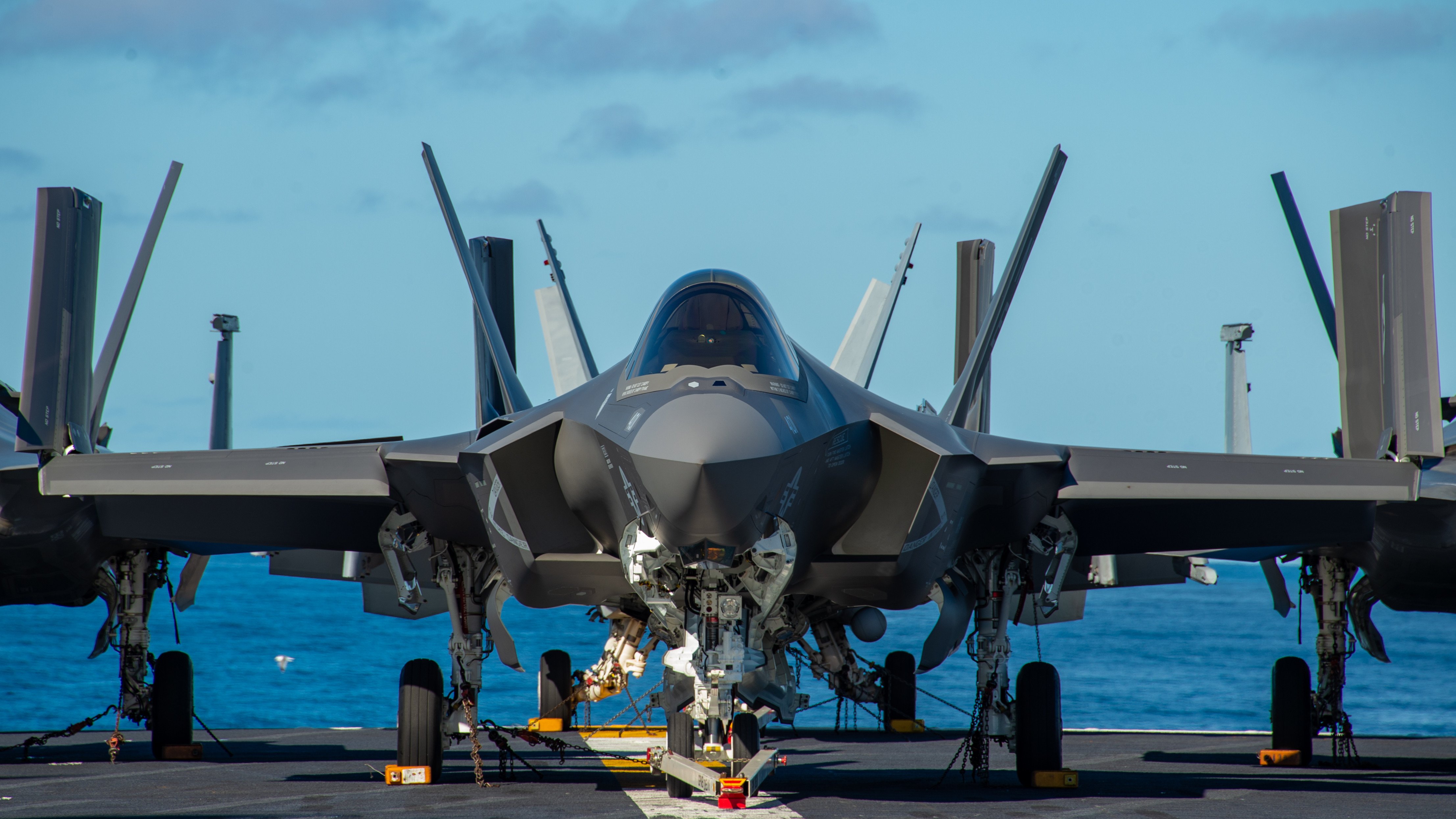
As the Navy approaches the first-ever deployment of its advanced carrier air wing – with the fifth-generation F-35C Joint Strike Fighter paired with the CMV-22B Osprey to serve as the carrier onboard delivery plane – leadership from USS Carl Vinson (CVN-70) and Carrier Air Wing 2 say they’ve ironed out many integration issues between the ship and the two new aircraft types and are ready for a final exercise this summer to prove they can deploy.
CVW-2 is wrapping up its advanced training at Naval Air Station Fallon in Nevada, honing the way the F-35C will interact with other aircraft types and use its new sensors and computing power to elevate the performance of the entire air wing, the deputy commander told USNI News in a recent interview. This air wing-only training event comes after a Tailored Ship’s Training Availability and Group Sail in February and March that got entire strike group together for the first time, allowing the air wing to operate from the carrier and coordinate with surface combatants to conduct missions.
Capt. Tommy Locke, the deputy air wing commander, said CVW-2 is a denser air wing than ones the Navy has deployed recently. Additional aircraft include an extra E-2D Advanced Hawkeye and two additional EA-18G Growlers in the air wing to help maximize the F-35 capabilities, he told USNI News in a previous interview.
“There’s a unique challenge with that from the yellow shirts, the flight deck officers, moving around the aircraft, where they’re spotting them, how we’re setting them up for recoveries. And we ironed out a lot of those issues during TSTA, which was really good,” Locke said in an interview this month with USNI News.
“Again, looking at things as simple as storage, what we’re going to have onboard, where we’re going to put them onboard.”
Locke said the planning for the integration between the ship and the new air wing began in late 2019 through wargames within the carrier strike group to understand logistics, deck density, how to move and spot aircraft on the deck and in the hangar bay and more. Though part of the air wing flew to the carrier in September 2020 for a deck certification event, TSTA was the first real chance to test out what the ship and the air wing had modeled.
Capt. P. Scott Miller, the Vinson commanding officer, said in a separate interview that, by the end of TSTA, “it seems like [the F-35C] has always been there.”
A lot of work went into preparing the ship and the air wing for the integration event, but the captain – a fighter pilot himself – said the new aircraft fit right into the carrier strike group environment.
“They more than fill the roles of their predecessors. They’re a little different, specifically the CMV-22. … We continue to work through the testing milestones, but it’s been seamless,” Miller said.
Asked what having the F-35C in the air wing means for the ship and how it can operate, Miller said, “it will enable us to push the fight further away, extend the range – so either supporting missions ashore or defending the carrier strike group – and make that be a further-away problem, which is always a good thing for us, protecting the high-value asset.”
Locke said that, in terms of launching from, flying around and landing on the carrier, the F-35 was no different than any other jet. The CMV-22B tiltrotor, though, took some effort to integrate into cyclic operations. Its predecessor, the C-2A Greyhound, was a fixed-wing plane that used catapult launches and arrested landings to come and go, just like the jets. Though the Osprey can fly like a plane, it lands and takes off like a helicopter – which Locke said is much easier on the airframe and the passengers onboard – so it took some work between the “Titans” of Fleet Logistics Multi-Mission Squadron (VRM) 30 and the flight deck crew to integrate a vertical takeoff and landing into the quick pace of cyclic operations on a carrier deck.
After the integration opportunity during TSTA, Locke said he’s confident that the V-22 can quickly transfer supplies and people to and from the ship and that the flight deck crew knows the right places to land and park the aircraft without affecting the rest of the flight cycle.
Miller said the ship needed to do a little more work to complete its integration with the V-22, including ensuring it can perform certain alternate missions as well as the C-2A could. A recent exercise involved using the CMV-22B as a medical evacuation platform, to make sure they didn’t need to make any alterations to the aircraft, the gear or the process of getting an injured sailor on a stretcher onto the aircraft to be flown ashore.
He said upcoming work will include testing the turnaround time of bringing passengers onto the carrier, for example, and then stripping the seats out from the V-22 and getting it ready to take an F-35 engine back ashore.
“We keep exploring and expanding the envelop of operations to not only meet what we had with the C-2 Greyhound but also exceed in some areas, specifically like we’re talking about with the power module delivery,” Miller said.
Locke praised the CMV-22B as being more flexible and agile than the C-2A. It can go longer distances, is more comfortable for passengers and can operate at night for resupply missions – whereas the C-2 is limited to the day.
Air Wing Fallon
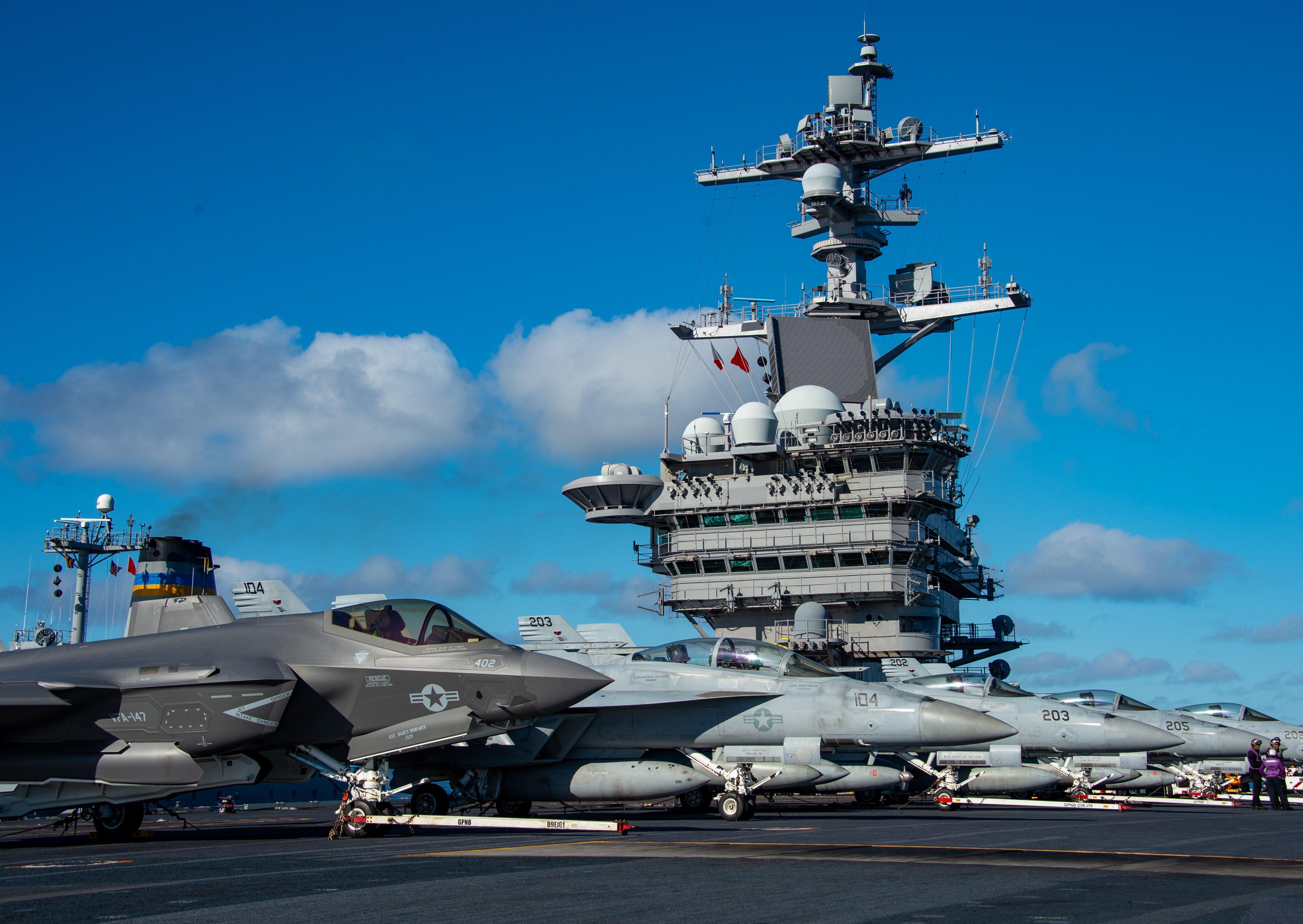
Last fall the three F/A-18E-F squadrons and the F-35C squadron – the “Argonauts” of Strike Fighter Squadron (VFA) 147 – conducted advanced readiness programs, including an air-to-surface program, as part of their basic training, Locke said. The air wing was able to bring the E-2D Advanced Hawkeye and EA-18G Growler squadrons out to support those advanced readiness programs as a first chance to start exercising the whole kill chain in a basic mission: suppressing enemy air defense systems on the ground.
TSTA and Group Sail was a chance to get the air wing together to integrate with the carrier and surface combatants, but Locke said the air wing’s time at Naval Air Station Fallon for its advanced training syllabus has been a really special time to understand and refine the relationships between different aircraft types within the air wing and how they’ll work together to create the most lethal and effective air wing possible for the Vinson CSG.
Locke said the Air Wing Fallon training has been going on for several weeks and will wrap up in May, and that it has focused on a range of traditional missions, from close air support to maritime strike missions to air-to-air combat – but with a twist.
“What I would call traditional mission sets doesn’t really apply anymore; the way we’re training and the threat we’re training against, the problem set is tougher across the board, whether it’s with our air wing or any other air wings that are coming along nowadays,” Locke said.
“We are trying to use as much redundancy in the kill chains across the air wing organically as we can. … In our unique configuration, the advanced capabilities we have with the F-35C, E-2D, EA-18G Growler, we’re able to leverage more depth in each of those bends of the [find, fix, track, target, engage, and assess] kill chain. Which I think is significant. And what we’ve found here at Fallon is, that has definitely increased our tempo of executing missions, it’s increased our lethality, it’s increased our survivability across all the platforms. So we’re not just looking at one platform: hey, they’re super lethal, they’re super survivable. But when we put up a strike of 20, 25, 30 airplanes, whatever the case may be, we’re spreading that lethality and that survivability across the entire strike package or air wing, if you will.”
USNI News previously reported that the Air Wing Fallon syllabus was being revamped to focus more on high-end warfare scenarios versus striking land targets – meant to prepare forces for a maritime fight against a complex and technologically advanced adversary instead of supporting ground wars in the Middle East. Locke said the new syllabus, plus his air wing’s unique capabilities with the F-35C, meant that “the events that we have in the syllabus are exponentially more difficult than they were when I went through Fallon in 2010 in the air wing.”
Most important, he said, the new syllabus gives the squadrons and air wing leadership more time for critical thought upfront about how each asset would support each other and contribute to various situations that could arise. The air wing was given a problem set, had time to plan, and then took the plan to rehearse and go through what-ifs and see if the relationships between the different assets held up. They’d then take lessons learned and refine the plan before flying it live.
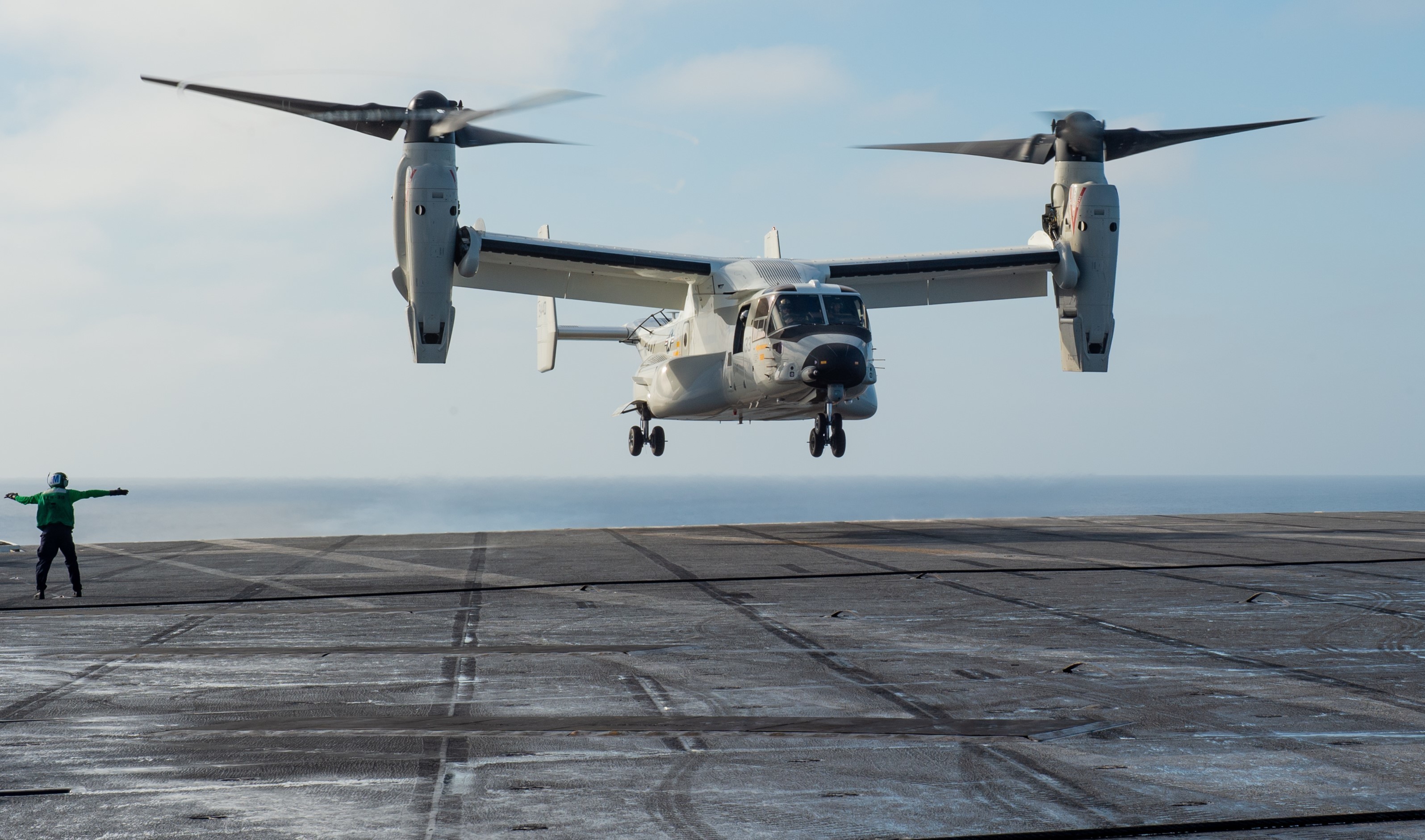
Locke said this new process helped immensely in understanding how to best leverage the new capabilities of the F-35C.
This work will inform the deployments of future air wings with the F-35C. Chief of Naval Operations Adm. Mike Gilday said in a House Appropriations defense subcommittee hearing today that the Navy was ramping up to a 50-50 mix of F-35Cs and F/A-18E-F Super Hornets in its air wings, and that “our goal is to have six aviation wings out of 10 that have the F-35 capability by 2025.”
After graduating from advanced training, Locke said, each squadron will have some readiness requirements to tackle for the squadron or for individual pilots, which they’ll work on until coming back to Vinson this summer for the composite training unit exercise (COMPTUEX), the final integration event prior to deployment. The ship, meanwhile, will be conducting pier-side maintenance until the start of COMPTUEX.
Miller said he hasn’t been told much yet about what to expect from COMPTUEX – whether it will hew to the traditional training events or be retooled to address the addition of the F-35.
“I can imagine that we would be both tested to the existing standard and then we would also explore the space and start seeing what expanded capabilities this aircraft does bring to the strike group, the air wing of the future in the strike group,” the ship captain said.
He said he talks to the air wing all the time about ideas for how to do things differently with the F-35C and the CMV-22B – whether it’s the way the carrier supports the air wing or the way the entire carrier strike group approaches its missions.
There’s constant discussion over “how we attack the traditional problems or even the changing problems that are being presented to us with our new air wing.”
“It’s a continuous dialogue between the warfare commanders, who are learning and looking for ways to apply the new capabilities that we have against the threats,” he added.
Specifically, the longer legs on both the F-35 and the V-22 are key.
“The gas is opportunity and decision space for us as we maneuver the ship and strike group. So the F-35 has a lot of gas in it,” he said. As a former F-18C Hornet pilot, limited gas was a known weakness for his plane, he said, and “so the extra fuel onboard does give us a lot of extra opportunities for just about every mission area execution.”
F-35 Engine and Logistics
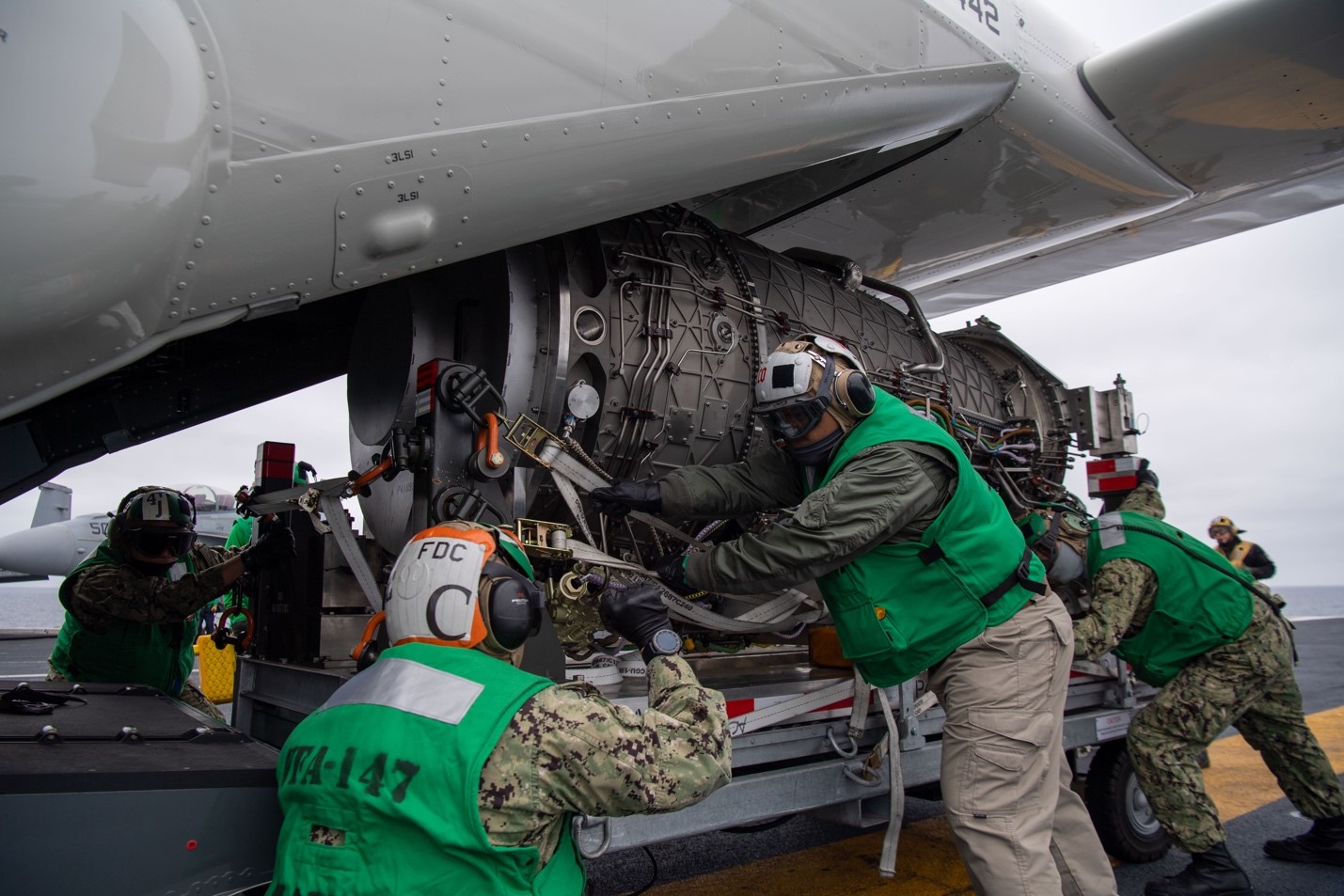
Going into F-35C acquisition and fielding, a key concern was the fact that the Joint Strike Fighter is a single-engine plane. The engine has proven quite reliable – in fact, during testing aboard USS Abraham Lincoln (CVN-72), an F-35C engine ingested debris from the basket of the Super Hornet that was refueling it mid-air, and the F-35C made it back to Lincoln’s deck safely. Still, the single engine is large – too large to be transported via a C-2A, which is why the V-22 was chosen to replace is for the COD mission – and many worried whether the Navy would be able to sustain the jets at sea if moving the engine around was so difficult.
The Vinson CSG says those fears can be put to rest: they not only conducted a V-22 movement of the F-35 power module, the main component of the engine, but they also demonstrated two other ways of lifting the power module to the carrier from a Military Sealift Command supply ship nearby.
“The engine obviously has been performing really well, it’s reliable, so that in itself keeps the stress level down. But there’s always unknowns that occur, and knowing that we have multiple paths to supporting the aircraft onboard, it’s just one less thing you have to worry about,” Locke said.
Rather than worry how close the carrier is to shore and if it’s within an easy flight for the V-22, he said, the carrier will always be supported by a supply ship for replenishment at sea for food, fuel and spare parts, and knowing that the engine can also come aboard that way, too, is one less thing for the air wing to worry about.
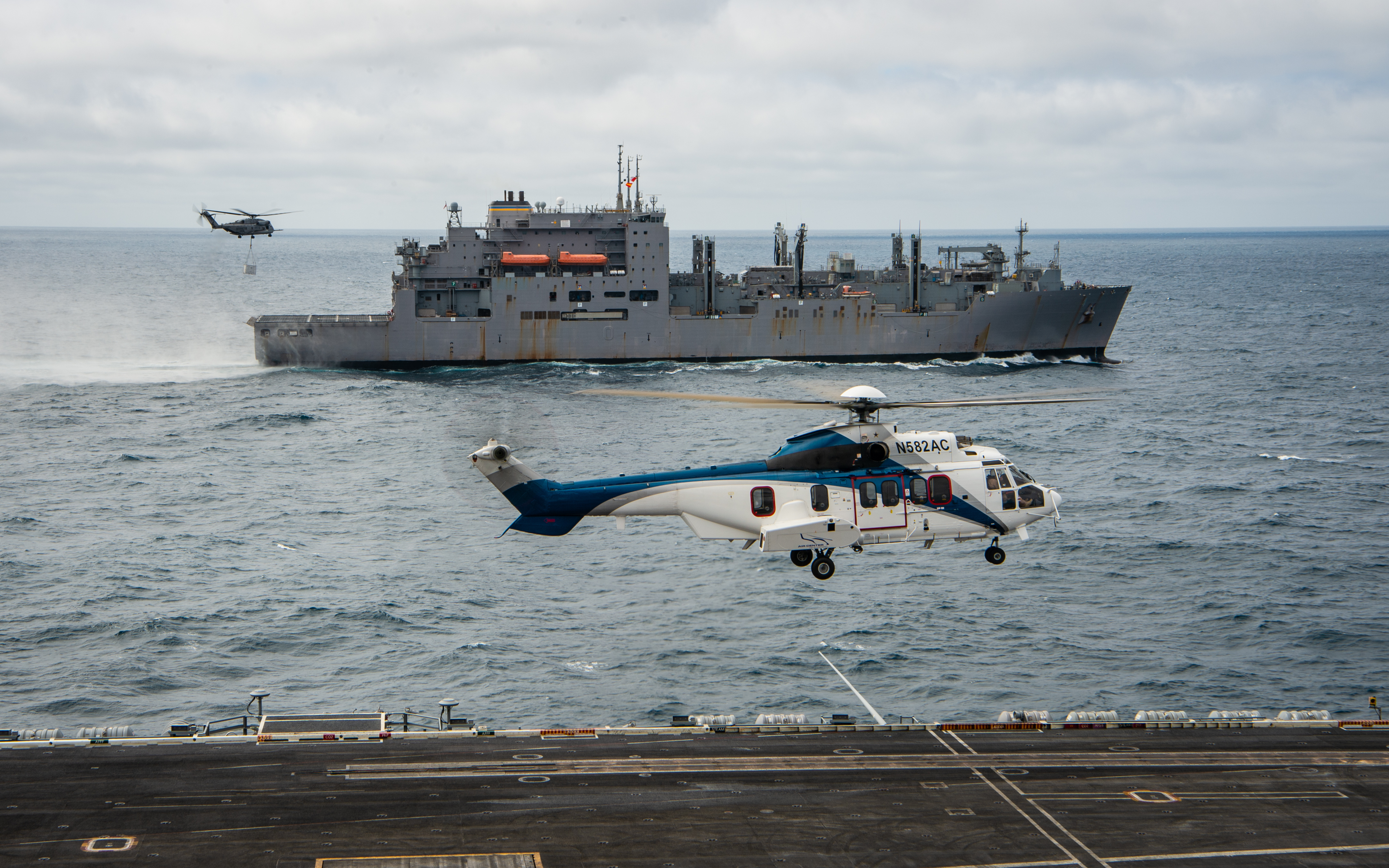
Cmdr. Melissia Williams, the Vinson supply officer, agreed that normalizing the ability to receive an F-35 engine via a replenishment ship was important.
“We receive parts, materials during our vertical replenishment – normally it’s up to about 130 pallets, but this one was a little bit different for us because of the weight and the size of the power module,” she said during a separate interview with USNI News.
It took some extra planning because the H225 Super Pumas usually carry standard-sized pallets and not anything so heavy and wide, but the March 6 demonstration involving dry cargo ship USNS Richard E. Byrd (T-AKE 4) was important to show that the ship can take on a new engine even as it brings aboard regular stores.
“The important thing is, we are now able to get the not-ready for issue power module off of our ship, over to the replenishment ship to take back ashore to get it back into the repair cycle so that it’s ready for another F-35, or to be returned to us as a usable part,” she said.
“It’s a matter of speed for us, because when you have a broken aircraft, we need to get that up very quickly … and now that we have three avenues to do that we can kind of plan and source the requirement to one of the three, depending on the situation we’re in.”
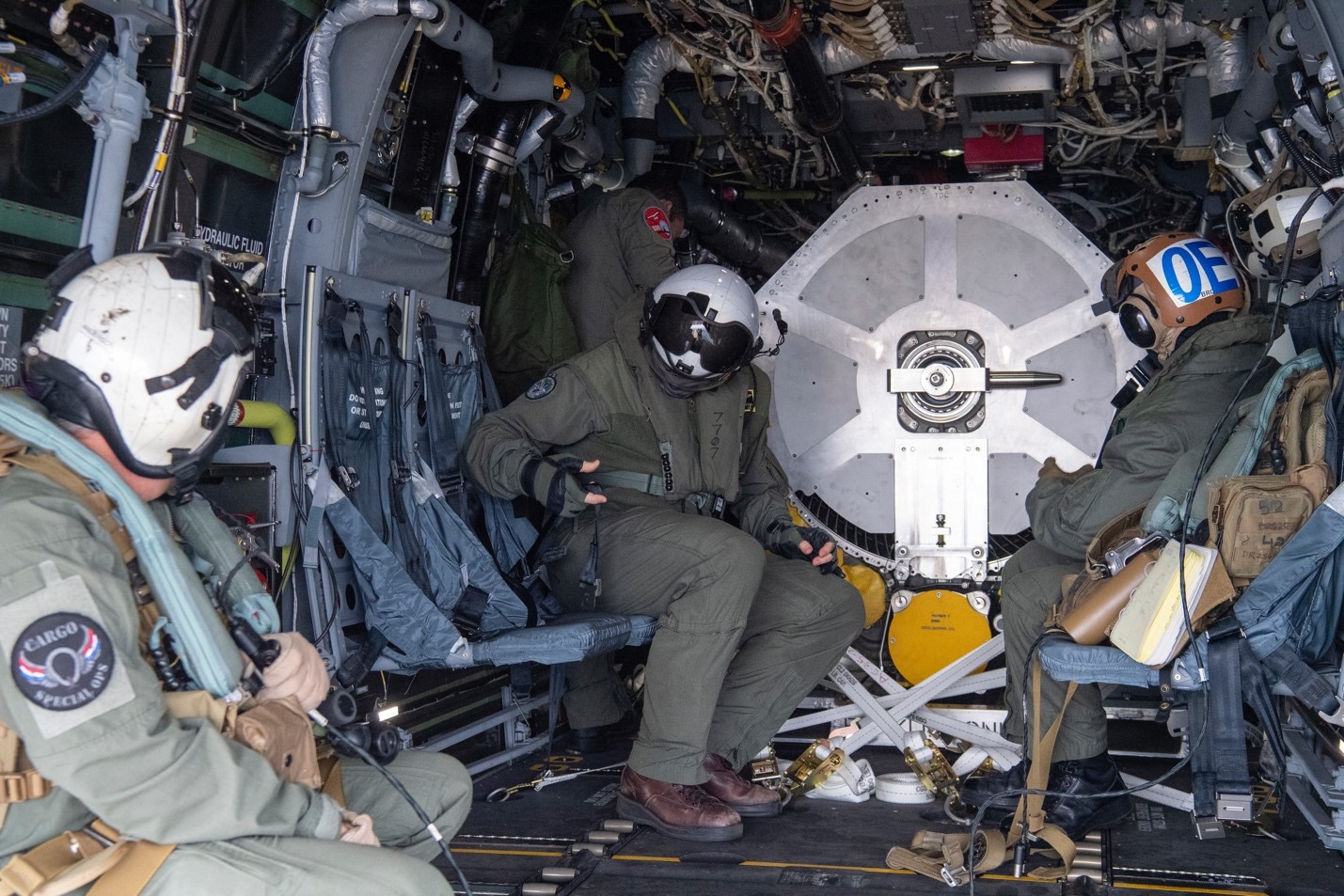
Miller said there was extensive planning by the ship and VRM-30 ashore before the CMV-22 demonstration – everything from how to load the power module into the back of the aircraft, to how to get it onto a sled so it can go onto the carrier, to how to move the engine on the sled into the hangar bay and the engine shop. After power point presentations and walk-throughs, he said the execution of the demonstration on Feb. 11 went well.
The vertical replenishment from the MSC ship to the carrier was conducted two ways – via a Marine Corps CH-53E heavy lift helicopter and a Super Puma sometimes used for vertical replenishments.
“So now we have three aircraft independently that can deliver the same capability to the ship,” Miller said.
Williams said the F-35 power module was the biggest logistics challenge with the F-35 but not the only one – specifically, some of the fifth-generation fighter’s spare parts are considered classified, which meant overhauling the storeroom setup to create separate classified areas. Additionally, having parts for two new classes of aircraft “kind of stretches our storeroom a little bit,” but she said the Navy did a lot of work up front to map out what the storerooms should look like, which gave her team on Vinson a good starting point last fall.
“Big Navy helped us out a great deal. They spent years of planning our spaces on board the ship, so they planned out hangar bay space for where the parts and materials will go and also storeroom space where we will store the material and parts. So they basically told us where to put them, how to put them; and we bounced back with questions about, hey, your drawings are off; and then we kind of reconvened, redeveloped and were able to come to a common ground on some of the parts and materials that they had laid out in some spaces that were not able to be used,” she said.
Her supply department is also in contact with Lockheed Martin and Boeing to share lessons learned about how the new aircraft hold up and what the turnaround time is for getting spare parts while operating forward in the Pacific.
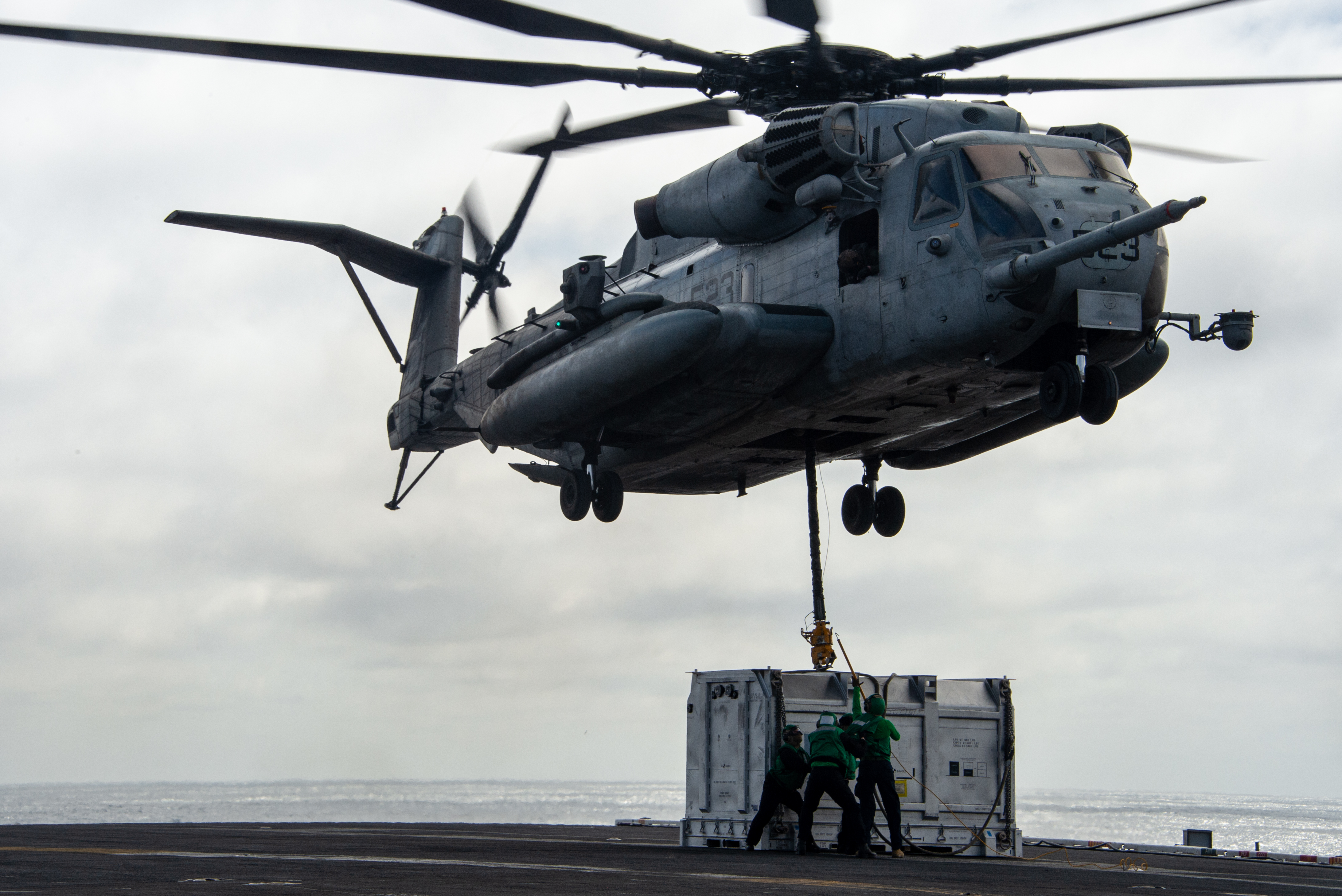
USNI News understands that Vinson will bring along an additional F-35 power module on the deployment through an agreement with engine-builder Pratt & Whitney. In a recent hearing, lawmakers grilled the company and the F-35 Joint Program Office over jet readiness trends, which have suffered due to a backup at the depot that fixes the Pratt & Whitney F135 engine and the power module inside it, leading to jets that are otherwise operable but can’t fly while they await a new engine. Having a spare already on the carrier would buffer the Navy from this backup during the maiden deployment of the new aircraft.
“So basically, we’re testing the systems’ availability of parts and also how quickly we can turn those parts around that are no longer serviceable – we call them not ready for issue parts, not RFI parts – back into the supply system to get repaired,” she said.
Williams said her department is working with Naval Air Forces, whose logistics specialists developed the allowances for spare parts on the ship. Vinson will continue to work between now and deployment on getting the storerooms stocked to those allowances, and the upcoming COMPTUEX will help the department see first-hand whether those allowances turn out to be sufficient for keeping up with air wing operations.
“We’ve worked with the F-35 and the V-22s for a short amount of time during these past two exercises with them, so the more familiar we are, the better we’ll get out there, and also we’ll be able to pass on lessons learned to the next aircraft carrier that will be deploying with these two platforms,” she said.





